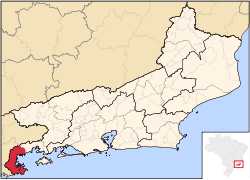This article needs additional citations for verification. (November 2008) |
Paraty | |
|---|---|
| Municipality of Paraty | |
 Location in Rio de Janeiro state | |
| Country | |
| Region | Southeast |
| State | |
| Government | |
| • Mayor | Carlos José Gama Miranda |
| Area | |
• Total | 928.47 km2 (358.48 sq mi) |
| Elevation | 5 m (16 ft) |
| Population (2020)[1] | |
• Total | 43,680 |
| • Density | 47/km2 (120/sq mi) |
| Demonym | paratiense |
| Time zone | UTC−3 (BRT) |
| CEP | 23970-000 |
| HDI (2010) | 0.693 – medium[2] |
| Website | paraty |
| Official name | Paraty and Ilha Grande – Culture and Biodiversity |
| Criteria | Cultural and Natural: (v), (x) |
| Designated | 2019 (43rd session) |
| Reference no. | 1308 |
| Region | Latin America and the Caribbean |
|
Preview warning: Page using Template:Infobox designation list with unknown parameter "buffer_zone" Preview warning: Page using Template:Infobox designation list with unknown parameter "Year" Preview warning: Page using Template:Infobox designation list with unknown parameter "area" | |
23°13′10″S 44°42′53″W / 23.21944°S 44.71472°W Paraty (or Parati, Portuguese pronunciation: [paɾaˈtʃi]) is a preserved Portuguese colonial (1500–1822) and Brazilian Imperial (1822–1889) municipality with a population of about 43,000.[3] The name "Paraty" originates from the local Guaianá Indians' indigenous Tupi language, named for an abundant local fish native to the region.[4] Paraty is located on the Costa Verde (Green Coast), a lush green corridor that runs along the coastline of the state of Rio de Janeiro, in Brazil. Paraty has become a tourist destination, known for its historic town center and the coast and mountains in the region. The historic center of the city, as well as four areas of the Atlantic Forest, were inscribed on the UNESCO World Heritage List in 2019 under the title "Paraty and Ilha Grande".[5]
- ^ IBGE 2020
- ^ "Archived copy" (PDF). United Nations Development Programme (UNDP). Archived from the original (PDF) on July 8, 2014. Retrieved August 1, 2013.
{{cite web}}: CS1 maint: archived copy as title (link) - ^ Estimativas das populações residentes, em 1º de julho de 2009, segundo os Municípios, IBGE
- ^ "A Change of Pace in Paraty". Travel. 2012-09-11. Archived from the original on August 9, 2022. Retrieved 2022-08-09.
- ^ "Five sites inscribed on UNESCO's World Heritage List". UNESCO. 2019-07-05. Retrieved 2019-07-05.







